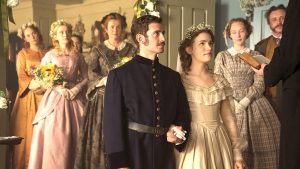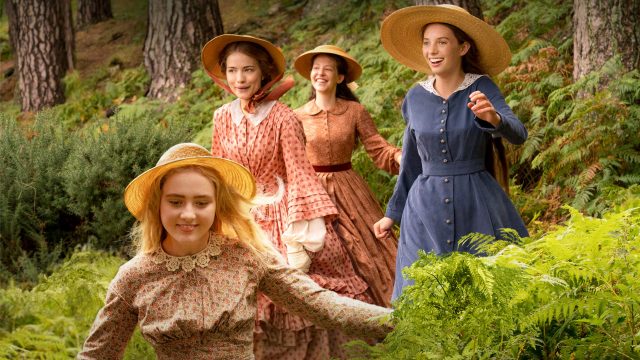A Review of Masterpiece’s “Little Women”
Over Memorial Day weekend I binge-watched the new version of Louisa May Alcott’s Little Women. Though my review was delayed due to history conference coordinating, I’m delighted to share a few thoughts on the new show. I suppose I could critic from the literary perspective, but this is a Civil War blog, so let’s talk about the Civil War and how it’s featured in this production.

Haven’t seen the show or read the book? Spoilers ahead – now you’ve been warned!
Need the one paragraph cliff-notes version of the story? Mr. March – an innovator who doesn’t make much money – and Mrs. March (Marmee) – a kind, wise, resourceful woman – have four daughters: Meg, Jo, Beth, and Amy. Set in the 1860’s and into the early 1870’s, the story follows the girls as they learn how to be “little women” through humorous and serious life experiences and lessons. Laurie – the boy next door – joins in the adventures of life in countryside Massachusetts and falls in and out of love with the girls. Each girl has her own dreams and ambitions, but they will either conform or rebel against 19th Century society’s norms at different times in the story.
Louisa May Alcott wrote Little Women in 1868, and it’s loosely based on her own childhood. Alcott served briefly as a nurse during the Civil War and includes hints of the conflict in her famous novel, though focusing almost exclusively on home life and the challenges of growing up, making her story a classic for decades.
In Masterpiece’s adaption was released on public television in the United States in May 2018, is still available on the website with some restrictions, and will be available on DVD soon. Here are a few Civil War related things to watch for in the new three-part series:

First, the Civil War is featured in this adaption and more prominently than in others I’ve seen. Yes, it does stray from the book in this regard, but I thought it really helped solidify the story’s setting. Instead of Mr. March’s mysterious absence from home, Masterpiece showed his work among the soldiers (presumably as a chaplain), his compassion to suffering soldier boy, his homesickness, and his time in a Union hospital. Showing this, helps to better illustrate some of Mrs. March and the little women’s struggles on the Massachusetts homefront, including limited financial resources.
There are also scenes where Marmee and the girls try to help a German family who’s struggling to survive the winter and illnesses. Taken in historical context, this is significant since the Civil War era was filled with prejudices against German-Americans; the March’s compassion and steadfastness to treat everyone by the Golden Rule stands out. Also significant is Jo’s wish to become a soldier and “follow Father to the field.” Little did she know that some girls did just that during the conflict.
In one scene, though, the Civil War themes are completely mutilated. Amy – the youngest sister – is attempting to cast her foot in plaster, one of her art attempts, while Meg – the oldest – perches on the bed, reading a newspaper. She comments on the Battle of Ball’s Bluff and then worries about Union conscription. It’s out of order since we’ve already seen one Christmas with Father away from home (presumably Christmas 1861) and Union conscription didn’t happen until 1863. Technically speaking, Meg wouldn’t be commenting on Ball’s Bluff like it’s recent news in summer 1862, and she probably wouldn’t be worrying about conscription at that time. Of course, I might be completely mistaken and it really came from an original newspaper that the actress or writing team had consulted.

My favorite “tie to war” in this adaption of Little Women is when Mr. John Brooke appears in uniform and his service in the Union army! In other versions, he just wanders off to war. Masterpiece gives us the full benefit of the scene with Meg’s expressions when she sees that uniform and considers if she really wants to become engaged to a financially poor soldier boy who might die on a battlefield. (Spoiler: she says yes to his proposal!) And then we see him march down the lane. A compilation of scenes shows John marching, fighting in battle, getting wounded, and coming home – appropriately short for the scope of the film, but still a nice addition to understanding his character and the couple’s relationship.
Overall, I really enjoyed the new adaption and was pleased to see the Civil War take a stronger part in the setting of the story. Sure, there were some things that bothered me with new version, and some parts seemed a little rushed, but the acting was good and the costumes were pretty. They didn’t completely butcher the book and even made a few changes that I enjoyed (I actually liked Laurie in this version and didn’t hate Amy at the end).

From a historically-minded viewpoint, I think it’s important to see this adaption’s more prominent inclusion of the Civil War as a positive innovation to understanding this coming-of-age story. The Civil War opened doors and new experiences for many young women – including some of the March sisters – and it’s significant to use the conflict in the interpretation of Little Women’s setting and in its original author’s experiences.
Have you seen the adaption? What did you think?
Check out the Masterpiece Little Women website for more details, video clips, podcasts, and activities.
Enjoyed both the Masterpiece adaptation of one of my favorite books and your interpretation. Thank you, Sarah Kay!
I prefer the 1994 movie over this TV series.
I agree, I like the 1994 movie better… I think the 1994 movie was more in keeping with the feel of Little Women (Part 1), and the Masterpiece series with Good Wives (Part 2).
My first Little Women viewing. Enjoyed it, but thought Brooke leaving the Marsh’s home in full kit to be unrealistic. It has caused me to read the book, so I am glad of this version.